
|
It passed only 0.036 a.u. from the earth on Mar. 21-22, and brightened up to 3.9 mag (Mar. 21, Thomas Lehmann). It keeps brightening even after the perihelion passage. It is very bright as 6.5 mag still now (Apr. 18, Marco Goiato). It keeps observable in excellent condition for a while after this both in the Northern Hemisphere and Southern Hemisphere. It may fade out very rapidly.
Date(TT) R.A. (2000) Decl. Delta r Elong. m1 Best Time(A, h)
Apr. 23 17 25.15 7 0.1 0.196 1.132 126 6.5 3:21 (180, 48)
Apr. 30 17 18.77 8 23.3 0.237 1.180 132 7.1 2:47 (180, 47)
|

|
Now it is 7.6 mag (Apr. 20, Marco Goiato). It will pass close to the earth from spring to summer, and it is expected to brighten up to 5-6 mag. But it is somewhat fainter than this ephemeris. In the Southern Hemisphere, it keeps observable in excellent condition after this. In the Northern Hemisphere, it locates low in the south.
Date(TT) R.A. (2000) Decl. Delta r Elong. m1 Best Time(A, h)
Apr. 23 23 31.00 -0 15.8 1.917 1.315 39 6.9 5:05 (255, 20)
Apr. 30 23 28.45 -1 46.0 1.767 1.322 47 6.8 5:10 (251, 28)
|

|
Now it is so bright as 10.0 mag (Apr. 15, Seiichi Yoshida). It will be fading slowly after this. It is observable in excellent condition in the Northern Hemisphere. It is observable in the evening sky also in the Southern Hemisphere until August.
Date(TT) R.A. (2000) Decl. Delta r Elong. m1 Best Time(A, h)
Apr. 23 11 8.56 53 34.7 2.183 2.617 104 10.0 21:01 (180, 2)
Apr. 30 11 2.63 49 54.4 2.282 2.664 100 10.1 20:27 (180, 5)
|

|
Now it is 10.5 mag (Apr. 7, Carlos Labordena). It was expected to brighten up to 4-5 mag from autumn to winter. But actually, it was 6 mag at best. Now it is fading rapidly. It is not observable after this in the Southern Hemisphere. It will be extremely low from May to June also in the Northern Hemisphere.
Date(TT) R.A. (2000) Decl. Delta r Elong. m1 Best Time(A, h)
Apr. 23 4 42.07 47 41.5 3.214 2.652 48 11.8 18:51 (142,-10)
Apr. 30 4 48.28 47 17.7 3.382 2.739 43 12.0 18:44 (140,-12)
|

|
Now it is 11.7 mag (Apr. 9, Seiichi Yoshida). It will brighten up to 11 mag from spring to summer. In the Northern Hemisphere, it will be getting lower after this, and will be unobservable in June. It locates somewhat low in the Southern Hemisphere, but it keeps observable until August.
Date(TT) R.A. (2000) Decl. Delta r Elong. m1 Best Time(A, h)
Apr. 23 6 36.39 22 47.4 1.984 1.812 65 12.1 18:51 (145, 23)
Apr. 30 6 52.13 22 41.5 2.013 1.781 62 12.0 18:44 (144, 23)
|

|
Now it is 12.2 mag (Apr. 8, Seiichi Yoshida). It keeps 12-13 mag for a long time from 2015 autumn to 2016 summer. In the Northern Hemispehre, it keeps observable in good condition for a long time. It keeps unobservable until July in the Southern Hemisphere.
Date(TT) R.A. (2000) Decl. Delta r Elong. m1 Best Time(A, h)
Apr. 23 19 35.83 71 14.8 2.690 2.709 80 12.2 5:05 (182,-16)
Apr. 30 19 9.54 72 0.1 2.674 2.722 81 12.2 4:37 (180,-17)
|
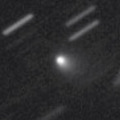
|
Now it is 14.0 mag (Apr. 15, Seiichi Yoshida). Brightening very rapidly, but it is fainter than this ephemeris. It is expected to be observable at 11 mag in good condition from spring to summer.
Date(TT) R.A. (2000) Decl. Delta r Elong. m1 Best Time(A, h)
Apr. 23 11 43.00 20 0.5 0.982 1.819 132 12.5 21:35 (180, 35)
Apr. 30 11 40.57 19 1.7 0.994 1.786 126 12.3 21:05 (180, 36)
|
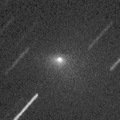
|
First return of an object discovered as an asteroid 2007 VA85 in 2007. It brightened very rapidly since mid February, and now it is so bright as 12.6 mag (Mar. 28, Thomas Lehmann). It is alreay unobservable in the Southern Hemisphere. It will be unobservable soon also in the Northern Hemisphere.
Date(TT) R.A. (2000) Decl. Delta r Elong. m1 Best Time(A, h)
Apr. 23 3 12.68 37 40.3 1.909 1.146 29 12.7 18:51 (124,-18)
Apr. 30 3 9.08 39 15.7 1.992 1.173 25 13.5 18:44 (123,-23)
|

|
Now it is 13.4 mag (Apr. 15, Seiichi Yoshida). It keeps 13 mag for a while. It is observable in excellent condition in the Southern Hemisphere. But it locates somewhat low in the Northern Hemisphere.
Date(TT) R.A. (2000) Decl. Delta r Elong. m1 Best Time(A, h)
Apr. 23 15 55.66 -23 20.5 1.369 2.302 151 13.2 1:52 (180, 78)
Apr. 30 15 51.48 -23 25.0 1.349 2.317 158 13.3 1:20 (180, 78)
|

|
It is observable in excellent condition in the Southern Hemisphere. Now it is faint as 17.2 mag (Apr. 16, Jean-Francois Soulier).
Date(TT) R.A. (2000) Decl. Delta r Elong. m1 Best Time(A, h)
Apr. 23 19 53.79 -25 19.3 5.729 5.943 97 13.6 5:05 (227, 76)
Apr. 30 19 55.04 -25 16.7 5.618 5.941 103 13.6 5:10 (197, 80)
|

|
Now it is very bright as 13.0 mag (Apr. 17, A. Novichonok, G. Borisov). In the Northern Hemisphere, it is observable at 13-14 mag in excellent condition until June. It locates very low in the Southern Hemisphere.
Date(TT) R.A. (2000) Decl. Delta r Elong. m1 Best Time(A, h)
Apr. 23 23 23.63 27 16.6 1.988 1.381 40 13.7 5:05 (233, 4)
Apr. 30 23 16.38 29 59.6 1.871 1.392 46 13.7 5:10 (225, 8)
|
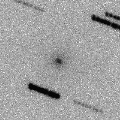
|
Now it is bright as 13.0 mag (Apr. 14, C. Rinner, F. Kugel, A. Klotz, J. Nicolas). Although it was faint as 19.0 mag in January (Jan. 10, B. Lutkenhoner), it brightened rapidly in February. It keeps observable until May in the Northern Hemisphere, or until July in the Southern Hemisphere. But it keeps extremely low. The brightness differs in every apparition. It was not observed in the last apparition.
Date(TT) R.A. (2000) Decl. Delta r Elong. m1 Best Time(A, h)
Apr. 23 4 37.76 17 14.9 1.856 1.223 37 13.9 18:51 (119, 10)
Apr. 30 5 6.37 17 31.7 1.885 1.249 37 14.1 18:44 (121, 11)
|

|
It will brighten up to 11 mag from summer to autumn. It will appear in the morning sky in summer, but it keeps low for some time.
Date(TT) R.A. (2000) Decl. Delta r Elong. m1 Best Time(A, h)
Apr. 23 0 47.70 15 19.8 2.790 1.864 18 14.3 5:05 (254, -4)
Apr. 30 1 5.36 16 48.6 2.727 1.818 20 14.1 5:10 (251, -2)
|
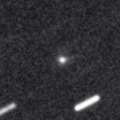
|
Now it is 14.7 mag (Apr. 11, Yuji Ohshima). It will be observable at 14 mag in good condition from spring to summer.
Date(TT) R.A. (2000) Decl. Delta r Elong. m1 Best Time(A, h)
Apr. 23 20 26.10 -13 45.4 2.256 2.430 87 14.6 5:05 (224, 63)
Apr. 30 20 35.35 -13 11.8 2.176 2.430 92 14.5 5:10 (212, 65)
|

|
Now it is 14.6 mag (Apr. 8, Seiichi Yoshida). It is observable at 14-15 mag in good condition from winter to summer.
Date(TT) R.A. (2000) Decl. Delta r Elong. m1 Best Time(A, h)
Apr. 23 12 52.90 -13 23.7 1.359 2.339 162 14.5 22:44 (180, 69)
Apr. 30 12 45.72 -14 10.7 1.385 2.336 154 14.6 22:10 (180, 69)
|

|
It will brighten up to 14 mag in summer. But it is not observable now. It will be observable at 16.5 mag in September in the Northern Hemisphere, or in November in the Southern Hemisphere.
Date(TT) R.A. (2000) Decl. Delta r Elong. m1 Best Time(A, h)
Apr. 23 3 51.39 14 6.9 2.879 2.028 26 14.7 18:51 (109, 3)
Apr. 30 4 7.65 15 3.1 2.899 2.017 23 14.6 18:44 (110, 1)
|

|
Now it is 15.1 mag (Jan. 2, Ken-ichi Kadota). Distant object, but it keeps observable at 14-15 mag for a long time from 2015 to 2016. It becomes unobservable temporarily from January to March in the Southern Hemisphere, or from February to April in the Northern Hemisphere.
Date(TT) R.A. (2000) Decl. Delta r Elong. m1 Best Time(A, h)
Apr. 23 23 47.08 -0 17.2 5.665 4.890 36 14.7 5:05 (258, 17)
Apr. 30 23 53.60 0 9.8 5.599 4.887 41 14.6 5:10 (253, 22)
|
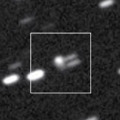
|
Now it is 15.3 mag (Apr. 17, J. Aledo). It is expected to brighten up to 7 mag in 2017 summer. In the Northern Hemisphere, it keeps observable in good condition until the highlight while the comet will be brightening. In the Southern Hemisphere, it is not observable until early 2017.
Date(TT) R.A. (2000) Decl. Delta r Elong. m1 Best Time(A, h)
Apr. 23 6 55.35 59 35.0 5.243 5.001 70 15.6 18:51 (165, -8)
Apr. 30 7 1.20 59 4.6 5.260 4.938 66 15.5 18:44 (163, -8)
|
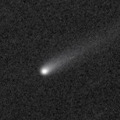
|
It brightened very rapidly in 2015 spring, and reached up to 13.8 mag (May 11, Sandor Szabo). It is bright as 14.4 mag still now (Apr. 8, Ken-ichi Kadota). It is observable in excellent condition in the Southern Hemisphere. But it locates somewhat low in the Northern Hemisphere.
Date(TT) R.A. (2000) Decl. Delta r Elong. m1 Best Time(A, h)
Apr. 23 13 56.73 -29 31.8 3.137 4.109 162 15.9 23:49 (180, 85)
Apr. 30 13 52.95 -29 7.9 3.161 4.136 163 16.0 23:17 (180, 84)
|

|
It brightened up to 3.7 mag and became a naked eye comet in mid January in 2015 (Jan. 13, Marek Biely). Now it is fading. It has already faded down to 16.1 mag (Mar. 26, Toshiyuki Takahashi). In the Northern Hemisphere, it keeps observable for a long time until the comet fades out. It locates somewhat low in the Southern Hemisphere.
Date(TT) R.A. (2000) Decl. Delta r Elong. m1 Best Time(A, h)
Apr. 23 18 25.97 25 50.8 5.087 5.443 105 16.1 4:21 (180, 29)
Apr. 30 18 22.72 26 16.0 5.078 5.506 110 16.1 3:50 (180, 29)
|
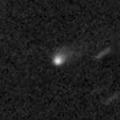
|
Now it is 16.0 mag (Apr. 14, H. Boussier). It will brighten up to 14 mag in 2017. In 2016, it keeps observable at 16 mag in good condition from winter to spring.
Date(TT) R.A. (2000) Decl. Delta r Elong. m1 Best Time(A, h)
Apr. 23 11 24.34 15 24.4 3.019 3.764 131 16.1 21:17 (180, 40)
Apr. 30 11 22.33 15 15.4 3.080 3.748 124 16.1 20:47 (180, 40)
|

|
Now it is 16.1 mag (Apr. 5, Yasukazu Ikari). It keeps 16 mag until autumn. It keeps observable in good condition for a long time in the Northern Hemisphere. It keeps unobservable in the Southern Hemisphere.
Date(TT) R.A. (2000) Decl. Delta r Elong. m1 Best Time(A, h)
Apr. 23 4 18.56 73 11.0 5.766 5.397 63 16.1 18:51 (162,-28)
Apr. 30 4 35.33 73 27.9 5.822 5.412 61 16.2 18:44 (162,-28)
|
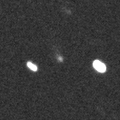
|
Now it is 16.6 mag (Mar. 30, J. Tuten, B. Lutkenhoner, R. C. Bubany, D. P. Dean). It keeps 16-17 mag for a long time until 2016 autumn. In the Southern Hemisphere, it keeps observable for a long time. It will be unobservable after this in the Northern Hemisphere.
Date(TT) R.A. (2000) Decl. Delta r Elong. m1 Best Time(A, h)
Apr. 23 4 17.60 -31 7.9 2.826 2.383 54 16.2 18:51 ( 72, 32)
Apr. 30 4 26.77 -31 54.6 2.802 2.363 54 16.2 18:44 ( 70, 31)
|

|
Now it is 16.7 mag (Apr. 15, Hiroshi Abe). It will brighten up to 16 mag from April to May. It is observable in excellent condition in the Southern Hemisphere. It locates somewhat low in the Northern Hemisphere.
Date(TT) R.A. (2000) Decl. Delta r Elong. m1 Best Time(A, h)
Apr. 23 15 45.40 -28 30.8 1.076 2.017 151 16.3 1:42 (180, 83)
Apr. 30 15 37.91 -30 44.9 1.054 2.022 157 16.3 1:07 (180, 86)
|
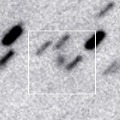
|
Now it is 16.5 mag (Apr. 5, Yasukazu Ikari). It keeps 16-17 mag for a long time from 2016 to 2019. It keeps locating near by the equator.
Date(TT) R.A. (2000) Decl. Delta r Elong. m1 Best Time(A, h)
Apr. 23 8 0.02 3 25.0 9.936 9.960 88 16.5 18:51 (158, 49)
Apr. 30 8 1.54 3 39.0 10.035 9.949 82 16.5 18:44 (151, 47)
|
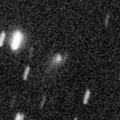
|
It brightened rapidly, and reached up to 15.5 mag (Feb. 11, Yasukazu Ikari). It will be fading after this. It has already faded down to 16.5 mag (Apr. 5, Yasukazu Ikari). It keeps observable until August when the comet becomes fainter than 18 mag in the Northern Hemisphere. It will be unobservable soon in the Southern Hemisphere.
Date(TT) R.A. (2000) Decl. Delta r Elong. m1 Best Time(A, h)
Apr. 23 8 12.53 37 9.7 2.419 2.525 84 16.5 18:51 (171, 17)
Apr. 30 8 18.40 38 31.0 2.516 2.519 78 16.5 18:44 (168, 15)
|

|
Now it is 16.8 mag (Apr. 12, K. Hills). The cometary activity is confirmed recently. It is expected to brighten up to 7 mag in 2017 spring. But it locates somewhat low at the high light.
Date(TT) R.A. (2000) Decl. Delta r Elong. m1 Best Time(A, h)
Apr. 23 11 13.49 -1 53.8 4.170 4.949 136 16.5 21:06 (180, 57)
Apr. 30 11 10.76 -1 27.5 4.183 4.881 129 16.5 20:36 (180, 57)
|

|
It brightened up to 11.1 mag in 2015 autumn (Sept. 21, Seiichi Yoshida). Now it is 15.3 mag (Apr. 6, Thomas Lehmann). It keeps observable in good condition after this, while the comet will be fading gradually.
Date(TT) R.A. (2000) Decl. Delta r Elong. m1 Best Time(A, h)
Apr. 23 11 13.53 13 3.2 2.097 2.857 130 16.9 21:06 (180, 42)
Apr. 30 11 12.46 12 42.8 2.220 2.905 123 17.1 20:37 (180, 42)
|

|
Now it is 16.6 mag (Apr. 9, MASTER-IAC Observatory, Tenerife). It keeps observable at 17 mag in good condition from winter to spring.
Date(TT) R.A. (2000) Decl. Delta r Elong. m1 Best Time(A, h)
Apr. 23 14 58.84 3 46.1 1.668 2.630 158 17.0 0:55 (180, 51)
Apr. 30 14 53.26 3 38.0 1.672 2.644 160 17.1 0:22 (180, 51)
|
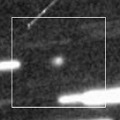
|
Appearing in the morning sky. It will be observable at 13 mag for a long time from 2017 to 2018. In 2016, it keeps observable at 16-17 mag in good condition until autumn.
Date(TT) R.A. (2000) Decl. Delta r Elong. m1 Best Time(A, h)
Apr. 23 20 23.55 -14 15.3 6.644 6.690 88 17.2 5:05 (223, 63)
Apr. 30 20 22.27 -13 52.6 6.477 6.646 95 17.1 5:10 (206, 67)
|

|
It brightened up to 13-14 mag from 2014 to 2015. Now it is fading. It will be observable at 17 mag in 2016.
Date(TT) R.A. (2000) Decl. Delta r Elong. m1 Best Time(A, h)
Apr. 23 22 54.35 -4 54.7 5.446 4.863 50 17.2 5:05 (253, 30)
Apr. 30 22 59.59 -4 28.9 5.404 4.904 55 17.2 5:10 (248, 35)
|
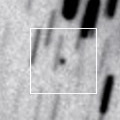
|
Now it is 17.4 mag (Apr. 14, ATLAS-HKO, Haleakala). It brightened rapidly, and became brighter than originally expected. It keeps 17 mag until 2017. It is observable in excellent condition in the Northern Hemisphere. It is not observable in the Southern Hemisphere.
Date(TT) R.A. (2000) Decl. Delta r Elong. m1 Best Time(A, h)
Apr. 23 15 51.14 75 1.2 7.222 7.307 90 17.2 1:47 (180,-20)
Apr. 30 15 30.07 75 18.5 7.243 7.303 89 17.2 0:58 (180,-20)
|

|
It brightened up to 11-12 mag in 2012. It has already faded down to 16.2 mag (Mar. 28, Toshiyuki Takahashi). It is observable at 17 mag in good condition from winter to spring.
Date(TT) R.A. (2000) Decl. Delta r Elong. m1 Best Time(A, h)
Apr. 23 10 26.76 -3 18.3 10.699 11.315 125 17.2 20:19 (180, 58)
Apr. 30 10 24.96 -3 1.6 10.836 11.352 118 17.3 19:50 (180, 58)
|

|
It was observed as bright as 13-14 mag for a long time from 2011 to 2014. Now it is fading. It is observable in excellent condition in the Southern Hemisphere. It locates extremely low in the Northern Hemisphere. No observations have been reported since August, 2015.
Date(TT) R.A. (2000) Decl. Delta r Elong. m1 Best Time(A, h)
Apr. 23 18 5.29 -34 47.8 8.760 9.321 121 17.3 4:01 (180, 90)
Apr. 30 18 2.21 -35 9.9 8.696 9.355 128 17.3 3:30 ( 0, 90)
|

|
Now it is 18.1 mag (Apr. 18, A. Diepvens). In the Northern Hemisphere, it keeps observable in good condition after this while the comet will be fading. It locates low in the Southern Hemisphere.
Date(TT) R.A. (2000) Decl. Delta r Elong. m1 Best Time(A, h)
Apr. 23 13 29.01 30 25.4 2.534 3.334 136 17.3 23:20 (180, 25)
Apr. 30 13 22.45 29 55.4 2.614 3.377 132 17.4 22:46 (180, 25)
|
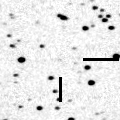
|
It was discovered around the aphelion in 2013 December. It keeps observable at 17 mag in good condition from 2016 to 2017. No observations have been reported since 2014 March.
Date(TT) R.A. (2000) Decl. Delta r Elong. m1 Best Time(A, h)
Apr. 23 12 17.02 5 46.7 1.896 2.799 147 17.3 22:09 (180, 49)
Apr. 30 12 12.24 5 52.5 1.916 2.766 140 17.4 21:37 (180, 49)
|

|
Now it is 17.1 mag (Apr. 8, D. Buczynski). It keeps 17.5 mag from 2016 to 2017. It is observable in good condition in the Northern Hemisphere. In the Southern Hemisphere, it locates low in 2016, and it is not observable in 2017.
Date(TT) R.A. (2000) Decl. Delta r Elong. m1 Best Time(A, h)
Apr. 23 17 25.65 26 57.9 5.925 6.444 117 17.5 3:21 (180, 28)
Apr. 30 17 23.25 28 14.3 5.870 6.432 119 17.5 2:51 (180, 27)
|
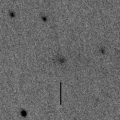
|
Now it is 18.3 mag (Mar. 9, C. Jacques, E. Pimentel, J. Barros). It was expected to brighten up to 14 mag from winter to summer. But it is much fainter actually. It will be observable in excellent condition in the Southern Hemisphere. It locates low in the Northern Hemisphere.
Date(TT) R.A. (2000) Decl. Delta r Elong. m1 Best Time(A, h)
Apr. 23 16 38.77 -36 32.1 1.659 2.496 137 17.5 2:35 ( 0, 88)
Apr. 30 16 37.03 -37 31.3 1.648 2.532 143 17.6 2:05 ( 0, 87)
|
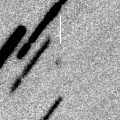
|
Now it is 17.3 mag (Apr. 19, C. Jacques, E. Pimentel, J. Barros). It will be observable at 17.5 mag in good condition from April to May in the Southern Hemisphere. It is not observable after this in the Northern Hemisphere.
Date(TT) R.A. (2000) Decl. Delta r Elong. m1 Best Time(A, h)
Apr. 23 18 5.82 -65 37.4 0.860 1.560 113 17.6 4:01 ( 0, 60)
Apr. 30 18 39.52 -70 60.0 0.871 1.566 112 17.6 4:07 ( 0, 54)
|

|
First return of a peculiar asteroid 1998 HO121. It brightened up to 16.5 mag in early 2015 (Jan. 4, M. Jaeger, E. Prosperi, S. Prosperi, W. Vollmann). It is observable at 17.5 mag again in 2016 spring.
Date(TT) R.A. (2000) Decl. Delta r Elong. m1 Best Time(A, h)
Apr. 23 13 42.42 -2 41.5 2.706 3.698 168 17.6 23:34 (180, 58)
Apr. 30 13 39.07 -2 9.2 2.754 3.726 162 17.8 23:03 (180, 57)
|

|
Very far object. Outburst occured on Feb. 20, 2015, and it brightened up to 15 mag. But it is faint as 18.4 mag now (Apr. 13, K. Hills). It is observable in excellent condition in the Southern Hemisphere. It locates somewhat low in the Northern Hemisphere.
Date(TT) R.A. (2000) Decl. Delta r Elong. m1 Best Time(A, h)
Apr. 23 13 19.01 -25 6.6 8.205 9.174 163 17.7 23:11 (180, 80)
Apr. 30 13 17.16 -24 47.9 8.222 9.176 160 17.7 22:42 (180, 80)
|

|
Now it is 17.9 mag (Mar. 19, iTelescope Observatory, Siding Spring). It keeps 17-18 mag for a long time from 2016 to 2017. In 2016, it is observable in excellent condition in the Southern Hemisphere, but it locates extremely low in the Northern Hemispehre.
Date(TT) R.A. (2000) Decl. Delta r Elong. m1 Best Time(A, h)
Apr. 23 12 0.01 -43 3.8 3.041 3.862 139 17.8 21:52 ( 0, 82)
Apr. 30 11 58.32 -41 26.9 3.020 3.827 137 17.7 21:23 ( 0, 84)
|
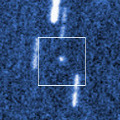
|
Now it is 17.4 mag (Apr. 15, H. Nohara). It becomes brighter than at the discovery in 2015. It is observable at 17.5 mag in good condition from spring to summer.
Date(TT) R.A. (2000) Decl. Delta r Elong. m1 Best Time(A, h)
Apr. 23 15 8.10 0 28.0 5.455 6.406 159 17.7 1:04 (180, 55)
Apr. 30 15 3.99 1 31.5 5.461 6.425 161 17.8 0:32 (180, 54)
|

|
It has not been observed yet in this apparition. It will be observable at 17 mag from spring to autumn. It will be extremely low after summer in the Northern Hemisphere.
Date(TT) R.A. (2000) Decl. Delta r Elong. m1 Best Time(A, h)
Apr. 23 14 48.62 -15 50.7 1.772 2.764 168 17.9 0:45 (180, 71)
Apr. 30 14 42.58 -15 56.7 1.732 2.738 176 17.8 0:11 (180, 71)
|

|
Although it was bright as 17 mag at the discovery in 2006, it faded out before the perihelion passage in 2008, and it became lost. Now it is fainter than 22 mag (June 15, 2015, Erwin Schwab, Marco Micheli).
Date(TT) R.A. (2000) Decl. Delta r Elong. m1 Best Time(A, h)
Apr. 23 16 0.01 5 39.7 3.650 4.517 145 17.8 1:56 (180, 49)
Apr. 30 15 56.77 6 1.3 3.610 4.511 150 17.8 1:25 (180, 49)
|
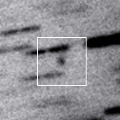
|
Now it is 18.0 mag (Apr. 12, A. Maury, J.-B. de Vanssay, J.-G. Bosch, J.-F. Soulier). It keeps observable at 17.5 mag in good condition from spring to autumn in the Southern Hemisphere. It is not observable in the Northern Hemisphere.
Date(TT) R.A. (2000) Decl. Delta r Elong. m1 Best Time(A, h)
Apr. 23 18 17.65 -61 14.3 4.603 5.089 113 17.9 4:13 ( 0, 64)
Apr. 30 18 18.97 -61 54.1 4.524 5.077 118 17.8 3:47 ( 0, 63)
|
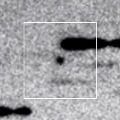
|
It keeps 16 mag for a long time from 2017 to 2018. Now it is 17.5 mag (Apr. 6, W. Hasubick). In the Southern Hemisphere, it keeps observable in good condition until early summer. It will be unobservable in May in the Northern Hemispehre.
Date(TT) R.A. (2000) Decl. Delta r Elong. m1 Best Time(A, h)
Apr. 23 8 57.06 -24 32.8 6.432 6.798 107 17.9 18:51 (179, 80)
Apr. 30 8 55.91 -23 19.4 6.492 6.768 101 17.9 18:44 (156, 77)
|

|
It is expected to brighten up to 16 mag and observable in good condition in autumn. However, it is so faint as 19.7 mag now (Apr. 16, A. Maury, J.-B. de Vanssay, J.-G. Bosch, J.-F. Soulier).
Date(TT) R.A. (2000) Decl. Delta r Elong. m1 Best Time(A, h)
Apr. 23 22 18.01 -17 53.8 3.552 3.229 63 18.0 5:05 (260, 45)
Apr. 30 22 26.08 -17 9.5 3.441 3.204 68 17.9 5:10 (255, 49)
|
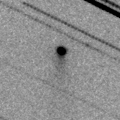
|
It passed only 0.024 a.u. from the earth on Mar. 23, and brightened up to 12.8 mag (Mar. 22, Paul Camilleri). Almost stellar. Fading very rapidly. It has already faded down to 18.2 mag (Apr. 19, Catalina Sky Survey). It is observable in excellent condition in the Northern Hemisphere. It keeps low after this in the Southern Hemisphere. The orbital elements are similar to those of 252P/LINEAR.
Date(TT) R.A. (2000) Decl. Delta r Elong. m1 Best Time(A, h)
Apr. 23 16 35.85 40 15.9 0.250 1.139 116 18.2 2:31 (180, 15)
Apr. 30 16 34.62 38 43.8 0.304 1.185 119 18.6 2:02 (180, 16)
|
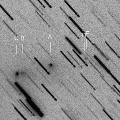
|
First return of a periodic comet which brightened up to 8 mag in major outburst in 2010. However, now it is faint; the fragment A is 19.3 mag (Apr. 6, K. Hills), the fragment C is 18.9 mag (Apr. 11, K. Hills). Fragments B to J are also observed.
Date(TT) R.A. (2000) Decl. Delta r Elong. m1 Best Time(A, h)
Apr. 23 9 40.44 15 30.0 0.972 1.612 109 18.4 19:34 (180, 40)
Apr. 30 9 52.75 13 16.6 1.031 1.627 105 18.6 19:19 (180, 42)
|

|
STEREO spacecraft observed it at 8-9 mag on Feb. 21-22. It approached to the sun down to 0.58 a.u. on Mar. 9, but it was not observable around the perihelion passage. It is appearing in the evening sky now. But it will fade out very rapidly.
Date(TT) R.A. (2000) Decl. Delta r Elong. m1 Best Time(A, h)
Apr. 23 5 7.74 16 21.9 1.420 0.999 44 21.3 18:51 (124, 15)
Apr. 30 5 45.51 17 13.5 1.493 1.092 46 22.3 18:44 (127, 18)
|
|
![]()
 104P/Kowal 2
104P/Kowal 2 43P/Wolf-Harrington
43P/Wolf-Harrington 53P/Van Biesbroeck
53P/Van Biesbroeck 77P/Longmore
77P/Longmore 118P/Shoemaker-Levy 4
118P/Shoemaker-Levy 4 C/2011 KP36 ( Spacewatch )
C/2011 KP36 ( Spacewatch ) C/2015 V2 ( Johnson )
C/2015 V2 ( Johnson ) C/2014 W11 ( PanSTARRS )
C/2014 W11 ( PanSTARRS ) C/2014 Q2 ( Lovejoy )
C/2014 Q2 ( Lovejoy ) 65P/Gunn
65P/Gunn C/2013 V4 ( Catalina )
C/2013 V4 ( Catalina ) C/2015 T4 ( PanSTARRS )
C/2015 T4 ( PanSTARRS ) 100P/Hartley 1
100P/Hartley 1 C/2014 B1 ( Schwartz )
C/2014 B1 ( Schwartz ) C/2015 Y1 ( LINEAR )
C/2015 Y1 ( LINEAR ) C/2015 ER61 ( PanSTARRS )
C/2015 ER61 ( PanSTARRS ) 67P/Churyumov-Gerasimenko
67P/Churyumov-Gerasimenko 180P/NEAT
180P/NEAT C/2015 O1 ( PanSTARRS )
C/2015 O1 ( PanSTARRS ) C/2012 F3 ( PanSTARRS )
C/2012 F3 ( PanSTARRS ) C/2014 R3 ( PanSTARRS )
C/2014 R3 ( PanSTARRS ) C/2006 S3 ( LONEOS )
C/2006 S3 ( LONEOS ) C/2010 S1 ( LINEAR )
C/2010 S1 ( LINEAR ) 19P/Borrelly
19P/Borrelly P/2013 YG46 ( Spacewatch )
P/2013 YG46 ( Spacewatch ) C/2014 OE4 ( PanSTARRS )
C/2014 OE4 ( PanSTARRS ) C/2014 Y1 ( PanSTARRS )
C/2014 Y1 ( PanSTARRS ) C/2016 C2 ( NEOWISE )
C/2016 C2 ( NEOWISE ) (347449) 2012 TW236
(347449) 2012 TW236 C/2013 C2 ( Tenagra )
C/2013 C2 ( Tenagra ) C/2016 B1 ( NEOWISE )
C/2016 B1 ( NEOWISE ) C/2015 LC2 ( PanSTARRS )
C/2015 LC2 ( PanSTARRS ) 89P/Russell 2
89P/Russell 2 P/2006 F1 ( Kowalski )
P/2006 F1 ( Kowalski ) C/2015 H2 ( PanSTARRS )
C/2015 H2 ( PanSTARRS ) C/2016 A1 ( PanSTARRS )
C/2016 A1 ( PanSTARRS ) 188P/LINEAR-Mueller
188P/LINEAR-Mueller P/2016 BA14 ( PanSTARRS )
P/2016 BA14 ( PanSTARRS ) 332P/2015 Y2 ( Ikeya-Murakami )
332P/2015 Y2 ( Ikeya-Murakami ) P/2003 T12 ( SOHO )
P/2003 T12 ( SOHO )![]()









































